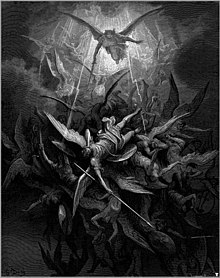| The Book of Giants | |
|---|---|
 | |
| Information | |
| Religion | Manichaeism |
| Language | Pahlavi, Aramaic, Syriac |
| Period | Before 2nd Century BC |
The Book of Giants is an apocryphal book which expands upon the Genesis narrative of the Hebrew Bible, in a similar manner to the Book of Enoch. Together with this latter work, The Book of Giants "stands as an attempt to explain how it was that wickedness had become so widespread and muscular before the flood; in so doing, it also supplies the reason why God was more than justified in sending that flood."[1] The text's composition has been dated to before the 2nd century BC.[2]
The Book of Giants is an antediluvian (pre-Flood) narrative that was received primarily in Manichaean literature and known at Turfan.[3] However, the earliest known traditions for the book originate in Aramaic copies of a The Book of Giants among the Dead Sea Scrolls.[4] References to the Giants mythology are found in: Genesis 6:1-4, the books of Enoch (Ethiopic, Slavonic, Hebrew, Greek), Jubilees, Genesis Apocryphon, 2 and 3 Baruch (Slavonic), the Damascus Document, and visions in Daniel 7:9-14.[5] This book tells of the background and fate of these ante-diluvial giants and their fathers, the Watchers (called grigori in the Slavonic 2 Enoch),[6][7] the sons of God or holy ones (Daniel 4:13, 17) who rebelled against heaven when — in violation of the strict "boundaries of creation"[8] — they commingled, in their lust, with the "daughters of men."[9]
Their even more corrupt offspring, the giants, were variously called thereafter nephilim, gibborim, or rephaim, being the earthly half-breed races that fought against God and his righteous followers whose numbers diminished as the world was overwhelmed with corruption and evil; the Manichaean fragments give these wicked ones the general name demons (Greek Enoch calls them bastards).[8] Though the terms for the Watchers and their offspring are often confused in their various translations and iterations, collectively these rebellious races are referred to as the fallen angels in the apocryphal sources, as also in the biblical narratives that reference them.[4]
- ^ "Genesis notes that corruption and violence were widespread and that human thoughts were continually evil, but it does not explain how that had come about"; VanderKam (2008/1995), pp. 41, 128.
- ^ Cite error: The named reference
Enoch Qumranwas invoked but never defined (see the help page). - ^ Cite error: The named reference
Ancient Giantswas invoked but never defined (see the help page). - ^ a b Stuckenbruck, Loren T. (1997). The Book of Giants From Qumran: Texts, Translation, and Commentary. Tübingen, Germany: Mohr Siebeck. pp. 24-28, 31, 72-74, 79, 81, 83, 90, 105, 114, 125-127, 143, 164-167, 182. ISBN 978-3161467202
- ^ VanderKam, James C. (2008) [1995]. Enoch: A Man for All Generations. Columbia: University of South Carolina Press. ISBN 978-1570037962.
See also the author's Enoch and the Growth of an Apocalyptic Tradition (1984), published by the Catholic Biblical Association of America: Washington, DC.
- ^ Milik, J. T., ed. (1976). The Books of Enoch: Aramaic Fragments of Qumran Cave 4 Archived 2019-03-28 at the Wayback Machine. London: Clarendon Press. pp. 43, 58, 92, 109-110, 113, 158, 171, 254, 300-316, 320, 328, 336-338. ISBN 978-0198261612
- ^ Orlov, Andrei; Boccaccini, Gabriele, eds. (2012). New Perspectives on 2 Enoch: No Longer Slavonic Only. Leiden, Netherlands: E. J. Brill Publishers. ISBN 978-9004230132.
- ^ a b Reeves, John C. (1992). Jewish Lore in Manichaean Cosmogony: Studies in The Book of Giants Traditions. Cincinnati, Ohio: Hebrew Union College Press. pp. 2-3, 9, 22, 30-32, 65, 67, 69-72, 76, 81-102, 109-110, 114, 118-121, 124-127, 130, 133-134, 138-139, 147, 154, 156-158 notes 334, 347 and 353, 207-209. ISBN 978-0878204137
- ^ Harkins, Angela K.; Bautch, Kelley C.; Endres, John C., eds. (2014). The Watchers in Jewish and Christian Traditions. Minneapolis, Minnesota: Fortress Press. ISBN 978-0800699789. Archived from the original on 2019-04-30. Retrieved 2019-04-30.